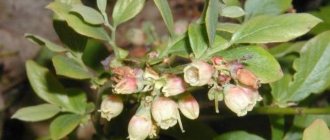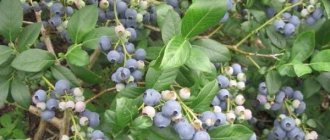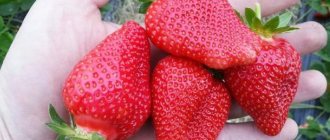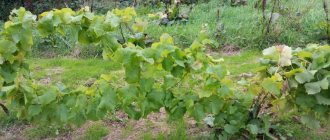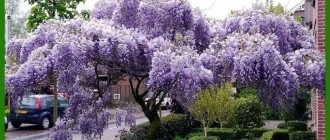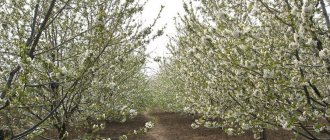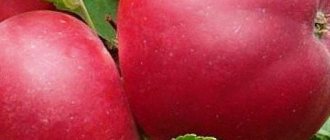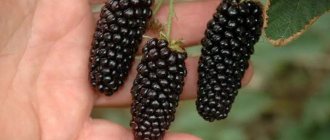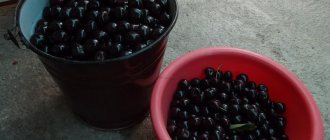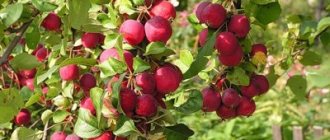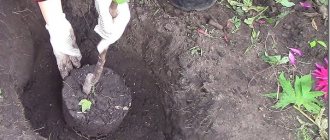Description of Erliblue blueberry
Erliblue blueberry is a medium-growing variety. The main varietal characteristics of the crop are early fruiting, resistance to frost and powdery mildew.
Features of fruiting
The Erliblue variety is self-fertile. Therefore, it needs cross-pollination. To do this, it is necessary to plant several different crop bushes on the site. The main thing is that the flowering dates of the selected varieties coincide (early July), this will ensure early ripening of Erliblue blueberries and improve the quality and quantity of fruits.
Blueberry stems have a reddish tint and grow up to 2 meters in height. The bushes do not form a large number of shoots, therefore they do not require constant pruning and thinning. The crop is also grown as an ornamental plant.
The fruits of the bush have a sweet-sour taste and contain a large amount of vitamins. During a season, you can collect about 5 - 7 kg of berries from a bush, and with special care the figures can reach 9 - 10 kg. The berries themselves weigh about 2 g, but do not fall off even when fully ripe.
The shelf life of the fruit is low - no more than 20 days, so the berries do not tolerate long-term transportation. In this regard, after harvesting, it is preferable to process or freeze the berries.
Advantages and disadvantages
Erliblue garden blueberry is a storehouse of vitamins and beneficial microelements, as well as a berry with excellent taste. But it also has its advantages and disadvantages.
Among the positive features of the variety are the following:
- early maturation;
- pleasant taste;
- frost resistance;
- ease of care;
- immunity to powdery mildew.
Disadvantages include:
- picky attitude to soil quality;
- low level of transportability of berries;
- extended period of fruit ripening.
Pros and cons of culture
The main advantage of Erliblue blueberries is their taste. The berries have a pleasant sweet taste. After ripening, the fruits are able to remain intact for a long time. In addition, Erliblue is characterized by high resistance to frost and immunity to powdery mildew. .
The main disadvantage of the plant can be considered its pickiness to the type of soil. The soil for planting should contain a large amount of humus and have an acidity in the region of 3.5-4.5. Also, the bushes are sensitive to gusts of wind, and the berries do not have the best transportability.
Features of reproduction
The blueberry variety Erliblue can be propagated by cuttings, seeds and layering. Seed propagation is not used in summer cottages, as it is a rather labor-intensive and time-consuming process.
Layerings are also rarely used for propagation, only if you have experience in breeding the variety in a similar way.
Cuttings are the main method of blueberry propagation. Shoots suitable for planting grow from buds formed on semi-lignified and woody cuttings.
Woody cuttings must be prepared in winter by collecting several branches in a bunch. They must be stored in a cellar or refrigerator.
Semi-lignified branches are cut off in mid-summer, after which they are immediately planted in the soil, using watering with special preparations that stimulate growth.
Propagation of blueberries
Garden blueberries are propagated using seeds, cuttings and layering. Propagation by seeds is used mainly by breeders; this method is not suitable for summer cottages, since it is a long and labor-intensive process.
Reproduction by layering also takes a lot of time. Therefore, the cutting method is more often used. For this purpose, woody and semi-woody cuttings are used.
Plant propagation by cuttings occurs due to the formation of new adventitious roots from plant tissues of the stem. Shoots grow from existing buds.
Woody cuttings are harvested in winter; annual shoots are chosen for this. They are cut and formed into bunches, which are put aside until the time comes to root them. Woody cuttings should be stored in the refrigerator or cellar. Most often, woody cuttings are prepared for transfer over long distances and planting for the next season.
Semi-lignified cuttings are harvested in mid-summer. To make them, young shoots of the plant are torn off, along with a small piece of last year’s bark. The leaves on the cuttings are cut to about a quarter. The lower part of the shoot is treated with preparations for root growth. The cuttings should be planted so that the remaining leaves on them do not touch each other.
Before the cuttings are completely rooted, the plant should be watered regularly and provided with oxygen.
Planting and care
Erliblue low-growing blueberry is a variety that is distinguished by its unpretentiousness. The main rule of cultivation is proper planting of the crop.
Recommended timing
The best time to plant Erliblue blueberries is spring and autumn. Before planting in any season, it is recommended to soak the seedlings in water so that they can be saturated with moisture for 10 - 20 minutes. After this, the root system should be slightly stretched. All this helps to saturate the roots with oxygen.
Site selection and soil preparation
In order for the seedlings to take root well, it is necessary to select high-quality soil for them. Erliblue is a blueberry that prefers soil whose acidity ranges from 3.5 to 4.5 pH. To impart the required acidity, peat, sawdust, foliage and other materials are used.
Erliblue does not tolerate high moisture, so the variety should not be planted in wetlands and on clay soils. If water stagnates in the soil, the blueberry roots will begin to rot and die.
Erliblue prefers sunny places, but the shade can cause a decrease in yield and nutrients in the berries.
Landing algorithm
Planting of seedlings is carried out in prepared holes, the width and depth of which is 50 cm, and the distance between them is at least 1.5 meters. They are filled with a substrate with the required level of acidity.
Planting blueberries can be done in a variety of ways.
The first option is to the ridge:
- It is necessary to dig a trench 10 cm deep and 100 cm wide.
- Pour the substrate into it to form a small mound.
- Plant a blueberry bush.
- Water.
The second option is wells:
- Make a trench or hole, the width of which will be at least 80 cm and the depth - 40 cm.
- Pour the prepared substrate there flush with the soil.
- Plant blueberries.
- Shed.
The third option is containers:
- Prepare a special container (plastic and wooden containers can be used).
- Make several holes in it.
- Cover with suitable soil.
- Dig the container into the ground (you can not deepen the container completely, the main thing is that it is stable).
- Plant a blueberry bush.
- Water.
Attention! The container should be 5 times the size of the blueberry rootball. It is advisable to choose a wider container so that the roots can grow wider.
Planting Erliblue in containers is preferable because it is easier to provide the plant with the right quality soil.
Landing rules
The culture loves sunny, secluded and warm places. Shrubs should not be planted in the shade, as this negatively affects the formation of flower buds and the quality of ripening berries, and the lack of sun and waterlogging contribute to the development of fungal diseases. Blueberries develop and bear fruit best in light, sandy, acidic soils with a high humus content.
For her, the correct soil reaction is one of the most important conditions for the formation of a good harvest: the optimal pH of the substrate should remain within the range of 3.8–4.8. The plant develops well in soil that warms up to +18…+21°C during the growing season.
Since the shrub bears fruit best in highly acidic soils, it is usually necessary to prepare a special area in the garden for it. The substrate must be enriched with organic matter; for this you can use acidic ground peat, which is mixed with native soil in a 1:1 ratio to a depth of about 40 cm. The surface of the bed under the seedlings is mulched with old sawdust, pine bark or last year's leaves.
Did you know? Blueberries give a person's hands a lasting blue color. In order to get rid of unnatural coloring, just wipe the skin with a cloth soaked in table vinegar.
Acidification of the blueberry area can be done in another way. To do this, dig a hole and then cover its walls with black (perforated or hand-pierced) film. You can also place an above-ground container (an old barrel, a large pot) in the ground with a hole for moisture to drain in the bottom. Next, a layer of acidic peat mixed with crushed pine bark (spruce needles, oak leaves, sawdust from coniferous trees) and sand is poured into the recess or container in a ratio of 2:1:1.
Recommendations for identifying blueberries for permanent placement:
- Shrub transplantation can be carried out in spring or autumn. Planting early in the growing season is less risky because young plants are not exposed to frost. The best autumn month for such work is September.
- It is best to buy seedlings in pots. Before starting the transfer work, the container with the plant is placed in water and left in this position until the entire root system is saturated with moisture.
- These berry bushes can be planted individually or in groups. If the gardener wants to plant them in rows, then they should be at least 2 m apart from each other. It is recommended to maintain an interval between plants of 80 to 150 cm.
- If you need to replant already growing blueberries, you should also first prepare a suitable substrate with the addition of acidic peat. The plant is removed from the ground along with the soil clod using a pitchfork, transferred and placed in a depression prepared in a new place. When dug this way, it retains most of the roots. Planting is carried out to the same depth. The best time to transplant an adult shrub is the second half of September.
- Since the blueberry harvest depends on pollination, the correct choice of planting neighboring plants is a very important factor when growing this crop in a personal plot. Erliblue should be planted next to several varieties with different ripening times, which will contribute not only to good yields, but also to the owner of the garden receiving berries for a longer period. Suitable varieties for this purpose include Early Blue, Patriot, Bluecrop, Bluejay, Berkeley, Jersey, Blugold, Herbert, Brigitta Blue and Darrow.
Growing and care
In order for Erliblue blueberries to look no worse in a summer cottage than in the photo, they need to be grown correctly. The crop needs fertilizing, regular watering, pest control and rare pruning.
Watering schedule
Since the yield of Erliblue blueberries depends entirely on the level of moisture in the soil, watering must be taken responsibly. The variety does not like stagnation of moisture at the roots, but does not tolerate drought well. Therefore, the shrub watering schedule must be strictly followed.
Experienced gardeners recommend watering shrubs twice a week. Moreover, every day there are two waterings - in the morning and in the evening. The amount of water is determined by the condition of the soil and the amount of precipitation. The average volume for each bush is 1 bucket at a time.
Important! During hot dry periods, the plant should be sprayed so that it does not overheat in the sun.
Feeding schedule
Fertilizing is one of the most important factors in growing blueberries, since the crop is demanding on soil acidity and can die if the required standards are not met. This variety must be fertilized according to a specific schedule:
- Mineral fertilizers are applied in the spring.
- Nitrogenous preparations are added in June, July and August.
- Phosphorus is applied in mid-summer and early autumn.
Attention! Organics are contraindicated for blueberries of this variety.
The main signs that a plant needs soil acidification are yellowing and dry foliage. The situation can be changed either with specialized preparations or by adding sulfur powder, ammonia, and citric acid (25 g per 5 liters of water) to the soil.
Trimming
The variety does not require annual pruning. To maintain the health of the bush, sanitary treatment is carried out, starting only from the 3rd year of blueberry life. To do this, dry and diseased bushes are removed. To make it more decorative, you can cut off root growths.
Preparing for winter
Since one of the distinctive features of Erliblue blueberries is that they are varieties with a high level of frost resistance, the crop does not require special preparation before winter.
The only exceptions are regions where the climate is considered harsh, and frosts reach -40 degrees. In this case, it is recommended to erect a bush shelter. For this, bark or pine needles and non-woven fiber are used.
Features of crop care
Garden blueberries require proper care, which consists of timely, regular watering, feeding the bushes with the necessary fertilizers, sanitary pruning and treatment for diseases and pests.
Watering and using fertilizers
Blueberries require proper and regular watering. Moisture at the roots should not stagnate for long, but its lack also harms the plant. The bushes should be watered two days a week, morning and evening, one bucket at a time. Blueberry productivity directly depends on watering. In hot weather, the plant should be sprayed to protect it from overheating.
See also
How to properly harvest olives, timing and necessary toolsRead
In early spring, mineral fertilizers should be applied to the soil. Organic fertilizers for blueberries are contraindicated. Nitrogen fertilizers should be added to the soil three times a season. In summer and autumn, add 100 grams of phosphorus fertilizer to the soil once.
Mulching and loosening beds
Sawdust is best suited for mulching beds, as it helps retain moisture and decomposes slowly. The thickness of the coating should be equal to one decimeter. Mulch must be laid around the bush within a radius of 50 centimeters. The procedure is carried out once after landing. Afterwards, the coating is changed if necessary if it begins to rot and deteriorate.
Formative pruning
Erliblue blueberries generally do not require annual pruning. Starting from the third year, sanitary pruning of the bushes is carried out - root growths are shortened, strong main branches are formed. The strongest shoots should be left. Weak shoots are eliminated. Starting from the age of six, the bushes undergo anti-aging pruning: old, outdated shoots are removed and young, fruit-bearing ones are left.
Preventive treatment of the bush
To prevent diseases and pests in early spring, treat plants with Bordeaux mixture. Remove damaged branches in a timely manner, prune blueberries in time to allow air circulation. After harvesting, the bushes should be treated with fungicides .
Wintering
The Erliblue variety is highly frost-resistant, so it practically does not need additional shelter for the winter, except in areas with very low, prolonged winter temperatures. In winter, the soil should be mulched using pine needles or bark.
In cold regions, non-woven fiber can be used to cover blueberries after pressing the branches to the ground with bricks or pieces of wood. First of all, shelter is needed to protect the plant from burns on sunny frosty days, since at night during this period the branches freeze very much, and during the day they heat up sharply. Because of this, cracks form on the branches.
Pests and diseases
Among the diseases to which blueberries of this variety are susceptible, there are both fungal and viral pathologies:
- mummification of berries;
- gray rot;
- black spot;
- stem cancer;
- anthracnose
Among pests, most often the only enemies of the crop are birds, from which the bush simply needs to be covered with a net.
To prevent the development of diseases, it is necessary to use special preparations that are used to treat blueberries at the very beginning of spring.
How to plant correctly
The key to success in growing garden blueberries is the correct choice of site and soil, adherence to deadlines and healthy planting material.
Recommendations for choosing deadlines
Planting Denis blue is practiced both in spring and autumn. If the gardener decides to plant bushes in the spring, the optimal time is late April, early May, depending on the growing region.
Requirements for location and soil
The place for planting garden blueberries should be well lit; the best location is the south or southwest side. Blueberries do not tolerate drafts well, and the bush does not grow in wetlands. The main requirement for soil is high acidity. The plant receives the full range of necessary nutrients in symbiosis with the mycelium of the fungus.
Site selection and preparation
The area for planting garden blueberries is prepared in advance. The soil is dug up, cleared of weeds, loosened, and fertilizers are applied.
When choosing a location, it is important to take into account the shading factor; in shade and partial shade, blueberry yields are halved
How to select and prepare planting material?
When choosing planting material, pay attention to the root system of seedlings. It should be well developed, without signs of rotting or mechanical damage.
Seedlings are purchased from agricultural nurseries and certified stores.
Planting scheme
Despite the fact that Denis blue forms a fairly compact bush, when planting in groups it is important to maintain a distance of at least one meter between plants, and at least 1.5 meters between rows. The depth of the planting hole is 60 centimeters, the diameter is 70 centimeters.
Erliblue highbush blueberry: variety description, photo, planting and care, winter hardiness
Registration for spring pruning has begun!
New entrance to the Nursery from spring 2021
Photo of Erliblue blueberry
Description of Erliblue blueberries
Berry diameter, mm
Description of Erliblue blueberries
Detailed description of blueberries of the Erliblue variety: large size, juicy, light blue fruits with a diameter of 17 mm, early ripening, with a very good taste, resistant to...
Features of planting and growing.
1. General information about blueberries. Useful properties of blueberries.
Blueberries contain a large amount of vitamins. Blueberry fruits have unique properties: they protect against the effects of radioactive radiation, strengthen the walls of blood vessels, normalize heart function, support the health of the intestines and pancreas, and slow down the aging of nerve cells, and therefore the brain. In addition, blueberries have antiscorbutic, choleretic, antisclerotic, cardiotonic, hypotensive and anti-inflammatory effects. It is effective for atherosclerosis, hypertension, capillary toxicosis, rheumatism, sore throat and other diseases associated with insufficiency of blood capillaries.
When consumed regularly, the berries relieve eye strain and help restore vision, just like when eating blueberries. Blueberry juice is given for fever, diseases of the gastrointestinal tract, and also to enhance the secretion of gastric juice. Blueberries are recommended for people working in hazardous conditions, since pectin substances are able to bind and remove radioactive metals from the body.
It has been discovered that blueberries contain a significant amount of phyllohioneine (vitamin K1), which takes part in the blood coagulation system. And also high blueberries are useful especially for older people for maintaining (activating) vitality.
2. Choosing a place for blueberries
— Blueberries require a well-lit place. Otherwise, the sugar content of the berries may decrease and the overall yield will decrease. A partial reduction in the winter hardiness of the bush is also possible.
— Blueberries do not tolerate stagnant water. If there is a possibility of flooding of the bush in the area, drainage should be done if possible.
— Blueberries require light acidic soil (pH 3.5-5). Otherwise, the bush will not develop or will die altogether.
How to increase soil acidity:
a) plant blueberries in peat;
b) pour acetic acid around the bush (100 g of acid per 10 liters of water. This activity should be repeated every 4-5 years);
c) add sawdust from coniferous plants under the bush (BUT: sawdust pulls nitrogen out of the soil, so to compensate, it is necessary to add nitrogen fertilizers with sawdust)
d) sprinkle needles of coniferous plants under the bush (BUT: needles may contain diseases and pests, so this method is not recommended for use)
3. Planting blueberries
— Blueberry seedlings should be buried 5-8 cm when planted in the ground
— Blueberries require cross-pollination, so at least two plants of DIFFERENT varieties must be planted on the site. In addition, the berries from cross-pollination are larger, have a better taste and have a more delicate skin. Planting 3-4 varieties of different ripening periods ensures an increase in the harvest season and reduces the risk of crop loss from frosts and other unfavorable factors.
— The feeding area of one blueberry bush is 1-2 sq.m. The distance between two adjacent bushes is 1-1.5 meters.
— Blueberries should be fed in the spring. On soils with acidity above 4.8, to maintain the required pH level, once a year (in spring) it is necessary to apply powdered sulfur 40-50 grams around each bush (for old bushes 60-70 grams). On soils with an optimal pH level, it is recommended to apply 90 g of ammonium sulfate, 40 g of potassium sulfate and 110 g of superphosphate per adult blueberry bush. You should not apply nitrogen fertilizers later than mid-July if you do not want the bush to lose its winter hardiness.
At your summer cottage, you can use the following scheme: apply 1 tbsp per two-year-old bush. a spoonful of complete mineral fertilizer, for a three-year-old - 2, for a four-year-old - 4, for a five-year and older bush - 8 tbsp. spoons of complete mineral fertilizer.
— Watering blueberries should be done 2 times a week at the rate of one bucket of water per adult bush, twice a day (in the morning and in the evening). Good watering is very important in the period July-August, when fruiting occurs, and at the same time flower buds are laid on the bushes, forming the next year's harvest. If there is a lack of moisture during this period, crop losses are possible both in the current and next year.
— Blueberries are a fairly frost-resistant crop, but in some severe winters, non-lignified young shoots may freeze. There is no need to be afraid of this - it recovers very quickly.
4. Blueberry pruning
With proper pruning, you can not only increase the yield of the bush and the size of the berries, but also save it from diseases.
— Blueberry pruning should be done in early spring before the buds open (usually the month of April)
— It is necessary to remove the oldest (over 7-8 years old) and diseased shoots.
Blueberry Patriot: variety description, photos, reviews, characteristics, pollinators
Blueberry Patriot is a fruiting perennial shrub that has recently become very popular among gardeners. This variety combines good yield indicators and ease of care.
In addition, due to its appearance, blueberries serve as a decorative decoration for summer cottages: in the spring they delight with lush flowering, and in the fall with lush green leaves and rich color of berries.
This article provides a detailed description of the Patriot blueberry variety, its advantages and disadvantages, as well as care features.
History of selection
The Patriot blueberry was developed in 1952 in North America. Breeders by crossing Earliblue, Dixi and Michigan LB-1 varieties obtained a new tall blueberry species, named in honor of the 200th anniversary of the union of the states - Patriot.
However, seedlings appeared on wide sale only in 1976 and were immediately appreciated due to their high yields and decorative features.
This crop was brought to Russia in the 90s of the twentieth century, but has not yet been included in the State Register of the Russian Federation.
Description of the Patriot blueberry variety
The elongated bush reaches a height of 1.5 - 1.8 meters, has not too dense, erect shoots that are not distinguished by branching. The oblong leaves are 8 cm long and 4 cm wide when young and have a slightly reddish tint; by maturity they acquire a rich dark green color. The plant has a fibrous, densely branched root system that extends into the ground up to 50 cm deep.
Blueberries bloom with white bell-shaped inflorescences, grouped in clusters, hanging down from the branches - during this period, the garden plot turns into a blooming paradise.
Description of berries
Patriot garden blueberries are collected on the branch into dense clusters (bunches). Before ripening, the fruits are red in color, which changes to light blue with a characteristic bluish bloom as they ripen. Their size is from 15 to 19 mm, their shape is flattened.
The skin of Patriot blueberries is elastic and smooth. The pulp is dense, slightly greenish, has a sweet taste and a very pleasant aroma.
Characteristics of the Patriot blueberry variety
Tall blueberry Patriot is a mid-early variety. Notable for its high yield - from 6 to 9 kg per bush, it is grown on an industrial scale. Thanks to the very large berries with strong skin, a mechanized harvesting method is possible.
The culture has good shelf life: it can be stored for up to two weeks without any problems, without losing its fresh appearance. The dense pulp and durable skin of blueberries allow them to be transported without compromising their integrity.
This variety easily tolerates temperatures down to -30 - 35 °C, which makes it possible to grow it even in regions with harsh climates.
Patriot blueberries are quite demanding on the composition of the soil and need acidic soils.
Indicators of 3.7 - 4.9 pH are considered optimal, but their approach to 5.5 pH will directly affect the reduction in yield and berry size. At 6.5 pH and above, the bush stops growing.
Too much acidity is also harmful: at pH levels of 2.9 – 3.2, a decrease in immunity is observed: then the plant dies from various diseases.
Main advantages
The advantageous characteristics of Patriot blueberries include:
- frost resistance;
- drought resistance;
- transportability;
- high immunity.
Since this variety has a characteristic upright and slightly spreading bush, its planting density per 1 sq. m. can be increased, unlike other varieties. This will not interfere with the convenience of picking berries and will save land on the garden plot.
Flowering period, ripening time, yield
It is believed that Patriot blueberries are a self-pollinating crop, but cross-pollination is recommended to increase yield. Only varieties with coinciding flowering periods can act as pollinators for Patriot blueberries: such as Duke, Spartan, Reka.
Patriot begins to bloom only towards the end of May; this process lasts 45 - 55 days. That is why the variety is classified as decorative fruit and berry crops. The first flowering occurs the next year after planting, but maximum fruiting rates can be expected only in the 5th - 6th year.
Important! It is undesirable to allow berries to form in the first year after planting, so during the flowering period all inflorescences should be picked off.
The berries ripen closer to the second half of July and can remain on the bush for 10 days, after which they begin to deteriorate. In the first 2 - 3 years, the yield per bush is about 2 - 3 kg per season, and in subsequent years it can reach from 7 to 9 kg.
Area of application of berries
Patriot blueberries are used in cooking to prepare various jams, sauces, syrups, fresh juices and juices. The fruits are dried, frozen and canned. Frozen berries are good in baked goods, as a filling for pies and muffins.
Resistance to diseases and pests
Describing the benefits of Patriot blueberries, I would like to highlight its good resistance to diseases caused by fungal infections and pests. In particular, this species does not suffer from such common ailments among other blueberry varieties as stem cancer, late blight and root rot.
Advantages and disadvantages of the variety
Blueberry Patriot has the following advantages:
- high yield rates;
- adaptation to moderate drought;
- good immune resistance;
- decorative properties;
- long-term preservation of fruits;
- high taste qualities.
Among the disadvantages of the variety, only two can be identified:
- demands on the soil: if they are not satisfied, the bush will die;
- reduction in berry size in the second half of fruiting (closer to the end of August).
The fact that the number of advantages significantly outweighs the disadvantages is what makes this variety so popular among blueberry lovers.
Which blueberry is better: Patriot or Bluecrop
Bluecrop, like Patriot, is a tall blueberry variety and also has high yields and good hardiness.
Reviews of the Patriot and Bluecrop garden blueberry varieties are quite similar.
However, compared to Patriot, Bluecrop berries have a mediocre taste, often even tart, but due to the larger amount of vitamins and beneficial microelements they are considered more useful.
Planting and caring for Patriot blueberries
Planting Patriot blueberries is permissible either in spring (April-May) or autumn (September-October). Before planting, you need to select a suitable location and prepare special soil.
Blueberries love well-lit, sunny areas, protected from strong winds and drafts. Ordinary garden soil is unsuitable for planting, so the soil must be prepared from a mixture of peat, sand and soil from a pine forest.
It is advisable to first measure the acidity level and adjust it to the optimal level.
When choosing a seedling, you should pay attention to the integrity and development of its root system, as well as the condition of the foliage and shoots: even the slightest signs of any disease will affect the positive outcome of the matter.
Algorithm and scheme for planting Patriot blueberries:
- Prepare a hole 40 - 50 cm deep and 70 - 100 cm wide.
- Prepare a substrate from peat, sand and pine sawdust.
- Place a stake in the center of the planting hole.
- Tie the trunk of the seedling to a stake and carefully straighten the root system.
- Fill the hole with substrate and compact it.
- Water generously and mulch with spruce needles and bark 7-10 cm high.
When planting, it is better to water with acidified water (add 100 ml of 9% vinegar per bucket of water). If the soil on the site is clayey, the depth of the hole should be at least 70 - 80 cm. A drainage layer (about 20 cm) is laid on the bottom to prevent water stagnation.
Subsequent care of the crop
Subsequent care boils down to regular watering and feeding the plant. Blueberries should be watered at least twice a week, with 10 liters of water per bush, with 5 liters poured in the morning and 5 liters in the evening. To maintain soil moisture longer, it must be loosened and mulched with pine sawdust or needles, peat, and gravel.
Since Patriot blueberries love acidic soils, once a week watering should be done with acidified water (as when planting).
You can acidify with ordinary table vinegar (100 ml per bucket of water), citric or oxalic acid (5 g per bucket of water) or battery electrolyte (30 ml per bucket of water).
If there is a stop in growth, watering with this solution is carried out more often, each time measuring the pH level so as not to overdo it.
Mineral fertilizers are applied three times a season: the first time - before the start of sap flow, the second - towards the end of May, and the third - after mid-July.
Optimal natural conditions for growing the variety are found in the Urals, Siberia and the Far East. However, planting and caring for Patriot blueberries in the Moscow region is not much more difficult, since the garden variety is adapted to the climatic conditions of this region.
In order for the bushes to bear fruit better, it is recommended to prune them starting from the sixth year after transplantation. First, it is necessary to remove the lower, empty branches. Secondly, all branches that are older than 6 years.
Pruning is done in early spring - before the sap begins to flow. At the age of 15 years, the yield decreases.
In this case, it is recommended to cut the entire bush at the root, and after 2 - 3 years the young shoots will begin to bear fruit again.
Preparing for winter
In each region, the preparation of blueberries for wintering takes place differently: this is explained by the difference in climatic conditions. In the fall, phosphorus and potassium fertilizers are applied, and mulching is carried out with a layer of 10 - 12 cm.
In order for the plant to overwinter better, in the Moscow region and Volga region it is wrapped in special breathable material. For this purpose, the shoots of adult bushes are bent to the ground and tied to wire arches, while the shoots of young ones are wrapped entirely. The lower part of the bush and roots are covered with spruce branches.
In Siberia and the Urals, there is no need to wrap the plant, since winters in these regions are quite snowy. Snow serves as excellent protection from frost.
Disease and pest control
Excessive soil moisture can lead to various diseases caused by fungi. To avoid such troubles, you should completely change the mulch every two years and carry out preventive measures. To do this, blueberries are sprayed with Bordeaux mixture twice a year - in early spring and in the second half of autumn.
Besides fungi, blueberries have other enemies:
- leaf roller;
- Chafer;
- scale insect;
- aphid;
- pine silkworm.
To combat them, the affected areas are treated with fungicides and insecticides.
Below is a photo of a Patriot blueberry bush with phyllostictosis leaf spot - the most common disease associated with high humidity.
Conclusion
Tall garden blueberry Patriot is a universal variety, adapted to harsh climatic conditions, and therefore feels good in almost all regions of Russia. It is distinguished not only by high yields, but also by its decorative properties. In addition, the berries of the Patriot variety have high taste and have healing properties.
Reviews of Patriot blueberries
Anatoly Komarov, 39 years old, Novosibirsk I read reviews on the forums about the tall Patriot blueberry and became eager to grow several bushes in my dacha. Apparently, the soil in my area is quite acidic; I did not take any special measurements. My bushes are already in their third year, growing well and blooming too. Before this I picked the flowers, but this year I left them: I expect to get a good harvest. Victoria Kramarova, 49 years old, Chelyabinsk I really love blueberries, there are already several early ripening varieties on my plot in the Moscow region. 7 years ago I planted three bushes of the Patriot variety - I really want to enjoy the delicious berries throughout the summer. Planting and caring for Patriot garden blueberries are not very different from other varieties. My bushes winter well, grow quickly, the harvest is quite plentiful - about 5 - 6 kg per bush per season. By the way, the berries of this variety are really sweeter than others. Mikhail, Kozin, 51 years old, Ryazan I planted a seedling about five years ago, but I still haven’t been pleased with the yield. It turns out that cross-pollination is necessary. I plan to buy a couple of new varieties this spring.
Source: https://agrognom.ru/berries/bilberry/golubika-patriot-posadka-i-uhod.html
Characteristics of the variety
To understand whether it is worth growing Bonus blueberries on your plot, you need to study its detailed characteristics. The variety has both advantages and disadvantages.
Main advantages
The Bonus variety is popular among gardeners due to its numerous advantages:
- Blueberries tolerate drought well. Although a lack of moisture can affect the volume and quality of the crop, during short periods of drought the shrub does not dry out or turn yellow.
- Bonus - a very winter-hardy variety. The plant grows calmly in regions with winter temperatures down to -35 °C. Blueberries are not afraid of return frosts, even if they occur during the flowering period.
- Blueberries Bonus are great for transportation. The fruits of the plant are shelf-stable, can be stored for a long time at low temperatures, and do not wrinkle.
- The Bonus variety grows well in acidic soils - the ideal acidity level is 3.8-4.8 pH.
The fruits of Bonus blueberries do not wrinkle and are well transported. In general, Bonus blueberries can be considered a plant that is unpretentious to growing conditions.
Flowering period, ripening time, yield
Blueberries bloom in the second half of May and continue until mid-June. The description of the variety states that Bonus is a self-pollinating plant, but in practice it still needs pollinators; they increase the yield at least twice. The Erliblue, Nelson and Bluecrop varieties are well suited as Bonus blueberry pollinators.
If during flowering Bonus blueberries are pollinated by shrubs of other varieties, the yield increases greatly
The ripening of fruits in the variety is uneven and occurs in several stages. You can start harvesting as early as mid-July, but the bulk of the fruits ripen by mid-August. You need to remove the berries from the bush after they acquire an even bluish color.
The Bonus variety is considered high-yielding. From an adult blueberry bush you can remove up to 6 kg of berries, and under ideal growing conditions and proper care - up to 8 kg.
Area of application of berries
Blueberries can be stored in the refrigerator or cellar for up to 7 days. Most often, when grown for personal purposes, Bonus is consumed as a berry dessert. You can also make jam, jam or squeeze juice from the fruits.
Resistance to diseases and pests
In general, the variety is considered hardy and has good immunity. Of the fungal diseases, fruit rot and gray rot pose a danger to it, and among harmful insects, blueberries are affected by aphids and caterpillars. With good care from diseases and pests, Bonus rarely suffers.
Advantages and disadvantages of the variety
According to the description of blueberries Bonus, the following advantages can be identified:
- very large fruits with a dessert taste;
- high productivity;
- resistance to most diseases;
- increased cold resistance;
- suitability of fruits for transportation;
- attractive presentation.
At the same time, it is necessary to note the disadvantages of the variety, namely:
- uneven ripening;
- sensitivity to soil composition, on neutral and alkaline soils Bonus develops poorly;
- the need for pollinators, without them the yield of the variety is reduced by 2-3 times.
The Bonus blueberry variety is demanding on the composition of the soil - the plant needs acidic soil. Any gardener can grow blueberries in their summer cottage, but to obtain high yields you will have to make an effort.
Erliblue, early and early ripening
Early fruiting and resistance to frost determine high market potential. Many consider the variety to be non-commercial due to its average yield, which does not prevent it from being successfully used in small and medium-sized production for the fresh market. Another candidate for plantations and gardens, early and tasty, is Erliblue blueberry, all about it.
Description of the Erliblue variety
Manual picking is practiced and is suitable for machine harvesting - the last pickings are quite labor-intensive due to the smaller berries over large areas. Use – as an early variety, it is used for the fresh market, in competition with late varieties with better storage and transportation capabilities, and for processing.
Earliblue (Earlyblube) was developed in the USA and has been in production since 1952. It is used in the USA and Europe as an industrial plant in medium and small volumes, and in amateur gardening.
The photo shows ripening clusters of blueberries, variety Erliblue.
Medium-sized type, semi-spreading habit. Stems are medium length, with a slightly reddish tint. The height of erect shoots is 1.2-1.8 m; they do not require frequent pruning. Productivity 4-7 kg per bush - as a rule, any description gives the average value between the yield of young plants and adults. The maximum value is possible with intensive cultivation technologies.
- The fruits are light blue with an intense blue bloom, spherical, slightly flattened. Tart, sweet and sour with an alluring aroma of wine and berries, pleasant taste, soft green flesh with a slight pinkish tint - the quality of the berries is excellent.
- The size of Erliblue berries is large and medium, collected in long open clusters, 15-18 mm in diameter, weight 1.8-2.2 g in average weight, larger in the first wave of fruiting, smaller during the last harvest. As a plus, they do not fall off for a long time after full ripening.
- The quality of the fruit is excellent, but the shelf life is not the best: about 17 days (compared to Bluecrop - about 22-23, Duke - 22) does not tolerate long-term storage well, as well as transportation over long distances.
- The leaf is elliptical, medium to large, young ones are pinkish, adults are dark green, dense, hard.
- The flower is large, with a subtle pink tint that is barely perceptible.
- Resistant to powdery mildew, weakly resistant to cord virus and berry mummification.
- Frost resistance according to Polish sources up to -37 C.
Reviews, advantages and disadvantages
As for opinions, Erliblue blueberries have mixed reviews: some complain about the heterogeneity of fruit in average weight, the extended fruiting period, while rejoicing at the early harvest - the first berry is always at a premium.
A much bigger disadvantage is the average transportability and keeping quality. The later ones generally have stronger skin and denser flesh.
However, this is a problem with most early honeycombs, and the differences with well-stored ones are not particularly significant.
In addition, the long-lasting pinkish color during ripening is a concern for those growing it for sale. Upon reaching maturity, the fruits are completely colored.
Among the disadvantages, some cite irregular fruiting - in some years the harvest is low, about 2-4 kg. If this is an adult bush 5-6 years old, then it happens due to improper pruning - thickening or excessive pruning, lack of fertilizing or weakening of the plants as a result of changes in soil pH.
Care and cultivation
It is recommended to plant compactly - the compact habit allows you to reduce the distance between plants in the row, which helps to increase industrial productivity. Ridges (bulk, organized on clay soils, mulched with agro-fabric or planting trenches, holes are located for better illumination from north to south. The soil is acidified in advance to a pH value of 3.8-4.8.
On hilly terrain, the rows are placed perpendicular to the slope. The distance between bushes is 1-1.5 m, with dense planting up to 0.7 m, between rows 3 m.
Planting nests are filled with organic substrate from high-moor peat, litter, and sand. As one example of proportions - 2:1:1 - peat: litter: sand. It is important to check the pH of the sand - it can change the pH of the substrate. You can add composted sawdust and pine bark. As an option - 1 part of high-moor peat, a third of pine litter, and part of garden soil.
On large plantations, the substrate is applied for milling; on small plantations, in the garden in trenches or holes. The diameter of the holes can be from 1 m to 80 cm, the depth is 40-50 cm. The pH is measured, adjusted with sulfur if necessary (at least 6 months before planting), and spilled with electrolyte - in extreme cases, orthophosphoric acid, ammonium sulfate.
The seedlings are planted 4-6 cm deeper than they grew in containers and watered. After planting seedlings more than 40-45 cm high, they are shortened - cut by 1/4. For mulching, acidic peat, rotted pine sawdust, needles, and bark are used.
Mulch will create favorable conditions for the life of mycorrhizae, maintain soil looseness and moisture, and somewhat maintain pH. A common method is to limit the planting hole: the bottom is lined with agro-fabric with holes for drainage, and the bottom is lined with drainage.
The emphasis in fertilizing when caring not only for Erliblue, but also for any variety of blueberry, is on nitrogen, potassium, calcium does not play a key role. Do not use calcium nitrate (potassium is added only in sulfate form) and the like, fresh manure. Ammonium forms of nitrogen are necessary, nitrate forms are harmful to blueberries.
The simplest option is a complete complex fertilizer for heathers, conifers, rhododendrons and other lovers of acidic soil. But don’t forget to measure the value - a litmus strip is suitable for the garden.
Since this rarity often produces an error, the bushes themselves will tell the gardener about it, but the farmer will have to acquire more serious measuring instruments.
As an example that does not encourage action: up to 90-110 g of ammonium sulfate, 40 g of potassium sulfate, and up to 100 g of superphosphate per adult plant per year. Fertilizers are applied in 3 doses: the first application is before buds open, at the beginning of spring, in April. The second third is applied during flowering, the third at the beginning of fruit formation. Potassium and phosphorus are applied in early spring.
As for pruning Erliblue blueberries, it starts at 3-4 years.
Annual pruning is not necessary - only sanitary.
The only thing is that it is necessary to eliminate the growth of the lower tier at a height of 35-45 cm. The emphasis is on the formation of strong skeletal branches - thin small growth is removed, pruning is emphasized on the periphery and drooping shoots. And so that there are fewer of them, in the first year of life the plants can be tied to stakes.
When rationing adult bushes, the most powerful, longest shoots of the formation are left - not all of them are like that. Last year's thin, weak ones are cut out next spring. After 6 years, anti-aging pruning is needed.
As for pinching, you don’t have to do this: firstly, it will provoke the formation of new growth points, the growth of new branches.
It is difficult to balance the supply of sufficient nutrition, it is difficult to predict the need for oxygen - the area of green mass responsible for the processes of photosynthesis remains the same.
It’s easier to just stop nitrogen fertilizing in early to mid-June - there will be nothing and no need to pinch.
Winter hardiness is good - for the winter the stems are mulched with pine needles, bark, etc., surrounded by snow on all sides. In cold regions - in the north of the Moscow region, the Urals, north-east of Ukraine, they are wrapped in non-woven fiber and bent down; young plants are covered according to the principle of grapes, bent down and fixed. For large plantings, shelter is not an option - medium- and low-growing varieties will be an alternative.
Source: https://vizazh-2.ru/sorta-golubiki/erliblyu-ranniy-i-skorospelyy/
